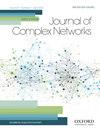通过多层网络分析教育科学协作:模式、影响和网络生成模型
IF 1.5
4区 数学
Q2 MATHEMATICS, INTERDISCIPLINARY APPLICATIONS
引用次数: 0
摘要
科学协作是教育领域的一个重要方面,对资源共享和政策制定具有重要的参考价值。随着教育研究的多样性和跨学科性的增加,了解各个子领域内部和之间的科学合作对其发展至关重要。本文采用主题建模方法,从2000年至2021年265种科学期刊的出版元数据中提取教育研究主题。我们构建了一个多层合作网络,其层代表了不同子领域的科学合作。比较了各层的拓扑性质,突出了热点和冷话题之间科学协作的差异和共同特征,主要区别在于存在一个显著的最大连接分量。此外,通过研究多层网络的结构度量,研究了跨层合作行为,揭示了作者在熟悉的子领域与熟悉的个体合作的倾向。此外,还研究了作者在网络拓扑上的特征与其h指数之间的关系。研究结果强调了确立明确的研究方向对提高作者学术声誉的重要性,以及跨层合作对扩大研究群体的重要性。最后,在上述结果的基础上,提出了一种多层科学协作网络生成模型,并验证了其有效性。本文章由计算机程序翻译,如有差异,请以英文原文为准。
Analysing educational scientific collaboration through multilayer networks: patterns, impact and network generation model
Abstract Scientific collaboration is an essential aspect of the educational field, offering significant reference value in resource sharing and policy making. With the increasing diversity and inter-disciplinary nature of educational research, understanding scientific collaboration within and between various subfields is crucial for its development. This article employs topic modelling to extract educational research topics from publication metadata obtained from 265 scientific journals spanning the period from 2000 to 2021. We construct a multilayer co-authorship network whose layers represent the scientific collaboration in different subfields. The topological properties of the layers are compared, highlighting the differences and common features of scientific collaboration between hot and cold topics, with the main difference being the existence of a significant largest connected component. Further, the cross-layer cooperation behaviour is investigated by studying the structural measures of the multilayer network and reveals authors’ inclination to collaborate with familiar individuals in familiar subfields. Moreover, the relationships between the authors’ features on the network topology and their H-index are investigated. The results emphasize the significance of establishing a clear research direction to enhance the academic reputation of authors, as well as the importance of cross-layer collaboration for expanding their research groups. Finally, based on the above results, we propose a multilayer network generation model of scientific collaboration and verify its validity.
求助全文
通过发布文献求助,成功后即可免费获取论文全文。
去求助
来源期刊

Journal of complex networks
MATHEMATICS, INTERDISCIPLINARY APPLICATIONS-
CiteScore
4.20
自引率
9.50%
发文量
40
期刊介绍:
Journal of Complex Networks publishes original articles and reviews with a significant contribution to the analysis and understanding of complex networks and its applications in diverse fields. Complex networks are loosely defined as networks with nontrivial topology and dynamics, which appear as the skeletons of complex systems in the real-world. The journal covers everything from the basic mathematical, physical and computational principles needed for studying complex networks to their applications leading to predictive models in molecular, biological, ecological, informational, engineering, social, technological and other systems. It includes, but is not limited to, the following topics: - Mathematical and numerical analysis of networks - Network theory and computer sciences - Structural analysis of networks - Dynamics on networks - Physical models on networks - Networks and epidemiology - Social, socio-economic and political networks - Ecological networks - Technological and infrastructural networks - Brain and tissue networks - Biological and molecular networks - Spatial networks - Techno-social networks i.e. online social networks, social networking sites, social media - Other applications of networks - Evolving networks - Multilayer networks - Game theory on networks - Biomedicine related networks - Animal social networks - Climate networks - Cognitive, language and informational network
 求助内容:
求助内容: 应助结果提醒方式:
应助结果提醒方式:


